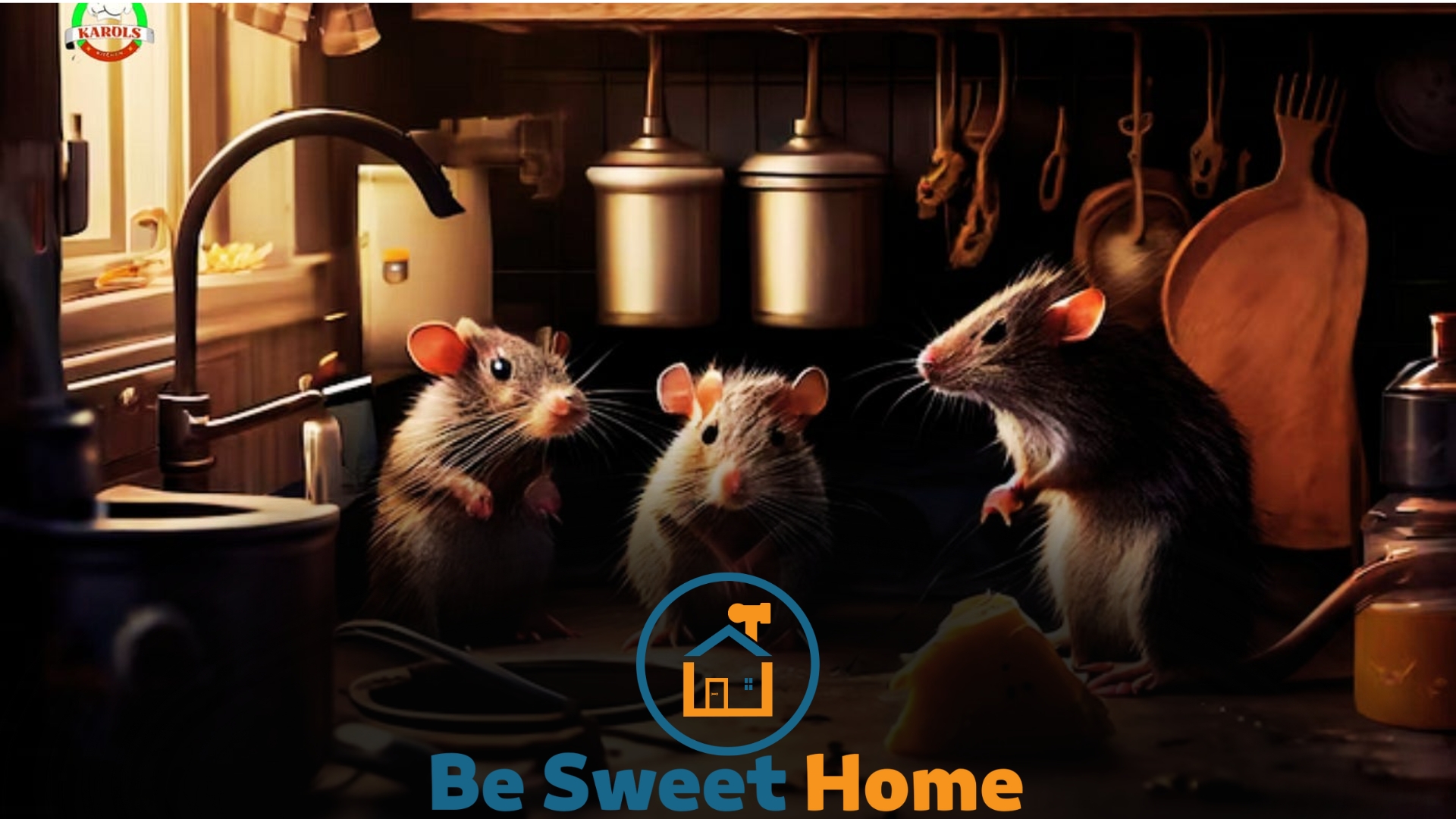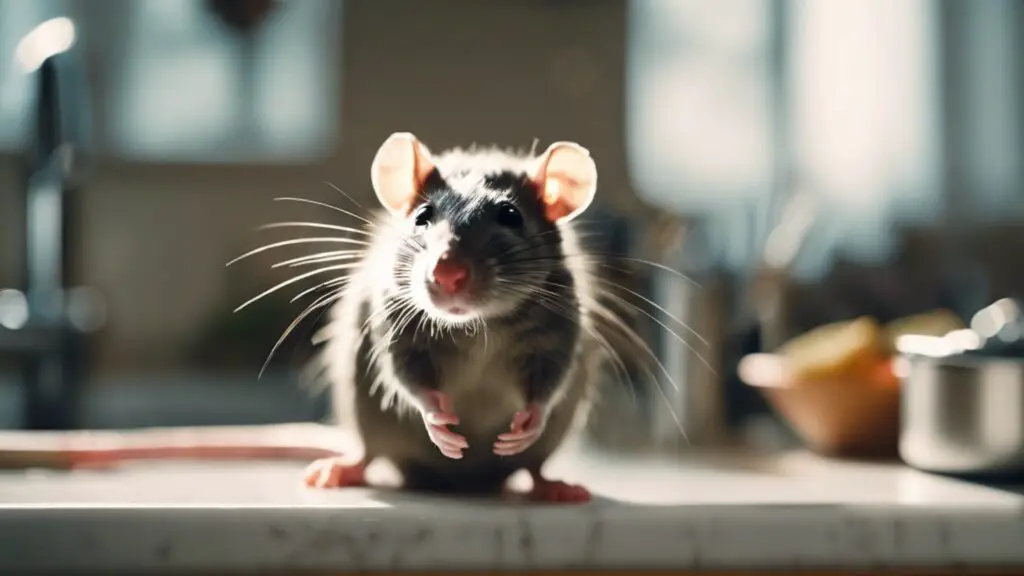

Immediately seal off the area and contact a professional pest control service to prevent the rat from escaping. Clean the kitchen thoroughly to eliminate any potential food sources or nesting materials.
Encountering a rat in your kitchen can be unsettling and pose health risks as these rodents are known carriers of diseases. They can also cause considerable damage to your home by gnawing on various materials.
A rat-proofing plan in place, including regular inspections and maintaining cleanliness, is essential.
Inspect your home for entry points and seal any gaps or holes. Store food in airtight containers and dispose of garbage regularly. Using traps and bait can be effective. However, these should be handled cautiously to avoid harm to pets and children.
Regular monitoring and swift action are key in ensuring that a solitary sighting doesn’t evolve into a full-blown infestation. Keeping your kitchen clean and clutter-free reduces the chances of rats making themselves at home.
Initial Reaction To a Kitchen Rat Encounter
Discovering a rat in your kitchen can be startling. Your initial reactions are critical to handling the situation effectively. Without further ado, let’s lay out the steps you should take after spotting a rodent in your culinary space.
Stay Calm
Rats are more scared of you than you are of them. It’s natural to feel afraid or disgusted. Yet, it’s vital to stay calm. Panicking can scare the rat, causing it to hide or act unpredictably, which could make the situation more challenging to resolve.
Observe the Rat’s Behavior
Take a moment to watch the rat from a safe distance. Notice where it goes. Does it have a specific route or a hole it escapes through? Identifying its movements can help you determine points of entry and plan how to prevent future visits.
| Observation Tips | Insights |
|---|---|
| Escape route | Locate entry points |
| Behaviors | Assess safety |
| Physical features | Identify rat species |
Jotting down these details will be handy. When you seek professional help, these observations will provide crucial information to the experts.
Immediate Steps To Take
Seeing a rat in your kitchen can be alarming. Taking the right actions quickly is crucial. Here are the immediate steps you should follow to address this unexpected visitor.
Safety Precautions
First and foremost, stay safe. Rats can carry diseases. Make sure to:
- Avoid direct contact with the rat.
- Wear gloves if you need to move anything.
- Keep children and pets away from the area.
Remove Food Sources
Rats look for food. Take swift action to remove it:
- Seal food in containers.
- Clean up any spills or crumbs.
- Store fruit and bread out of reach.
Isolate the Area
Keep the rat contained to avoid it moving to other parts of your home:
- Close the doors leading out of the kitchen.
- Block gaps under doors with towels.
- Take note of the rat’s hiding spots.
Identifying Entry Points
Finding where a rat has entered your kitchen is key to stopping future invasions. Rats can squeeze through surprisingly small cracks and holes. They will exploit any weak spot to get inside. Let’s figure out their common access routes and how to seal them off.
Common Access Routes for Rats
Kitchens can often have hidden entry points for rats. Rats look for easy ways in, so it’s vital to find these routes:
- Cracks in walls
- Openings around pipes
- Gaps in windows or doors
- Holes near cabinets or fixtures
- Spaces behind appliances like the stove or fridge
Check these areas thoroughly for droppings or gnaw marks as surefire signs of a rat’s presence.
Sealing Gaps and Holes
Stopping rats requires sealing off their pathways. Here’s how to do it effectively:
- Inspect your kitchen for any gaps, cracks, or holes.
- Measure the spaces that need sealing.
- Choose materials like steel wool, caulk, or wire mesh for smaller gaps.
- For larger holes, use metal sheeting or hardware cloth secured with screws.
- Ensure that seals are tight and leave no space for rats to squeeze through.
Rats can chew through soft materials, so it’s crucial to use durable ones for repairs.
Cleaning and Disinfection
Discovering a rat in your kitchen is alarming. Immediate cleaning is crucial to maintain hygiene. Let’s dive into effective cleaning and disinfection strategies.
Importance of Sanitation
Rats carry diseases and leave behind harmful bacteria. Sanitizing your kitchen reduces health risks.
Best Cleaning Practices
These practices ensure a safe and clean kitchen environment:
- Wear gloves and a mask.
- Remove any droppings or nesting material.
- Clean surfaces with soap and water.
- Disinfect with a solution of bleach and water.
- Dispose of cleaning materials safely.
Always thoroughly wash your hands after cleaning.
Long-term Rat Prevention Strategies
Finding a rat in your kitchen can be alarming, but you can keep these unwelcome guests away with effective long-term prevention strategies.
Ensuring the cleanliness and security of your food sources and home structure is critical in deterring rats. Below, we discuss key strategies to rat-proof your space.
Proper Food Storage Techniques
Rats are attracted to easy food sources. Use these methods to safeguard your provisions:
- Seal dry goods in airtight containers.
- Store fruit in the fridge or covered bowls.
- Dispose of leftovers promptly and properly.
- Keep pet food in sturdy containers with tight lids.
Remember, your trash can is a buffet for a rat. Use cans with secure lids and empty them regularly.
Regular Maintenance Checks
A tiny hole is a welcome sign for a rat. Conduct these checks to keep them out:
- Inspect your home’s exterior for cracks or gaps.
- Fill any openings with steel wool and caulk.
- Check vents, pipes, and cables for unsealed entry points.
- Trim branches away from your home to remove rat pathways.
Regular cleaning also helps. Sweep floors, wipe counters, and clean under appliances frequently.
Professional Help and When To Seek It
Spotting a rat in your kitchen can stir a wave of concern. It’s a sign that it might be time to call in the professionals for backup. Professional help is key when home remedies fail and the problem persists.
Signs You Need an Exterminator
Detecting the hallmark signs that point to a pest issue needing a pro is the first step:
- Rodent droppings around food packages, drawers, or cupboards.
- Unpleasant odors that hint at a hidden rodent nest.
- Gnaw marks on furniture or wires are clear indicators of rats.
- Noise, such as scratching sounds from within walls, especially at night.
Choosing a Pest Control Service
Selecting the right pest control service is crucial. Here’s how:
- Look for a licensed and reputable company.
- Read reviews and ask for recommendations from trusted sources.
- Ensure they use safe and effective methods.
- Check for a service guarantee to safeguard your investment.
Act promptly at the first sign of rodents to protect your home.

Frequently Asked Questions
How Do You Immediately React To a Kitchen Rat?
Stay calm and avoid sudden movements that might scare the rat into hiding. Gently guide it toward an exit if possible.
Can Kitchen Rats Transmit Diseases?
Yes, rats can transmit diseases, such as leptospirosis and salmonellosis, through their urine, droppings, and saliva.
What Attracts Rats To Kitchens?
Food scraps, crumbs, and accessible water sources attract rats to kitchens looking for sustenance.
Are Rats in the Kitchen Common?
Rats seeking food and shelter sometimes find their way into kitchens, which is a fairly common occurrence.
How To Prevent Rats in Kitchens?
Store food in sealed containers, keep the kitchen clean and seal potential entry points to deter rats from entering.
Conclusion
Encountering a rat in your kitchen can be alarming but manageable. Remember, acting swiftly and maintaining cleanliness are pivotal for prevention. For peace of mind, consult a professional exterminator.
Take these steps seriously, and you’ll ensure your home remains a no-go zone for these unwelcome guests.







